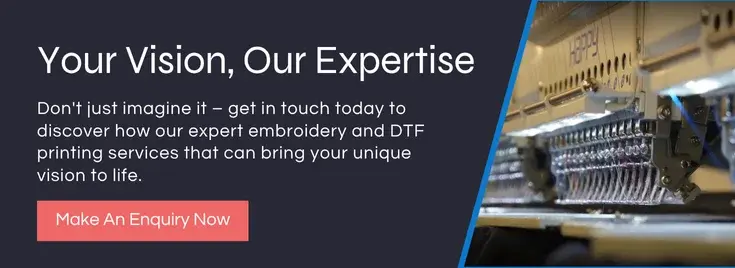
DTF, Screen Printing, Or Embroidery? Choosing The Right Garment Printing Service
A good garment printing service will usually offer various options, including direct-to-film printing (DTF), embroidery or screen printing options. These all have pros and cons to pay attention to, and there are differences in the type of finish that can be achieved, as well as in the durability and costs.
In this guide, we’ll compare the methods across five areas that matter most, which are the design detail, order size, durability, fabric compatibility, and price. This will help you choose the garment printing service that fits your needs best.
Design Complexity
DTF printing is ideal for detailed designs as it captures small text, shading and full colour images with ease. It works much like printing a photo onto film, which is then heat-pressed onto fabric. The result is crisp and vibrant.
Screen printing also handles detail fairly well, but it works best for bold graphics and limited colour palettes. The more colours you use, the more setup is needed.
Embroidery, on the other hand, has limitations with fine detail. It excels with clean, simple logos, but gradients or small lettering can get lost in the stitching. When deciding between embroidery or print, think about how sharp you need the image to be.
Order Size
Screen printing is best suited for large runs, as once the screens are made, printing many items becomes quick and cost-effective. DTF printing works well for both small and medium batches because it needs very little setup. You can print one item or a hundred without much change in cost.
Embroidery takes longer per item and tends to be more expensive for smaller runs. But for long-term uniforms or high-wear garments, it often pays off. If you’re stuck between embroidery or screen printing, consider whether you need 500 shirts for a one-off event or 20 polos for year-round use.
Durability
Embroidery wins hands down for long-term wear. The stitching holds up to repeated washing and tough use, which is why it’s a popular choice for workwear.
DTF prints are durable, too. They resist fading and cracking better than older print methods. Screen printing also holds up well, especially on heavier fabrics, but may lose colour over time depending on wash conditions.
If you're trying to weigh up embroidery or print from a durability angle, embroidery is stronger, but modern DTF comes close.
Fabric Compatibility
DTF is the most versatile because it works on cotton, polyester and nylon, as well as blended fabrics, which makes it suitable for everything from t-shirts to technical jackets.
Screen printing also handles a range of fabrics but needs the surface to be smooth and absorbent. Embroidery works best on thicker materials like polos, caps and fleeces, while lightweight or stretchy garments may not hold the stitching well.
Cost-Effectiveness
Screen printing is cheapest for big orders. The setup takes time, but once that’s done, the price per item drops fast. DTF is affordable for small to medium batches, while embroidery tends to cost more per unit because of the time it takes to produce. But for premium, long-lasting branding, many still see it as worth the extra spend.
To find out more about our embroidery or screen printing services, get in touch with our experienced team today.


